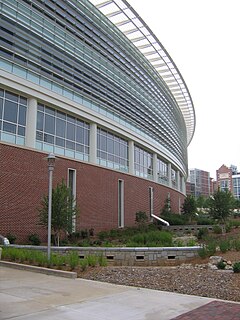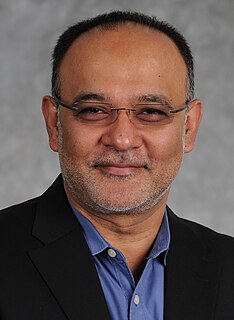
Scientific visualization is an interdisciplinary branch of science concerned with the visualization of scientific phenomena. It is also considered a subset of computer graphics, a branch of computer science. The purpose of scientific visualization is to graphically illustrate scientific data to enable scientists to understand, illustrate, and glean insight from their data.
Greg Turk is an American-born researcher in the field of computer graphics and a professor at the School of Interactive Computing in the College of Computing at the Georgia Institute of Technology. His paper "Zippered polygon meshes from range images", concerning the reconstruction of surfaces from point data, brought the "Stanford bunny", a frequently used example object in computer graphics research, into the CGI lexicon. Turk actually purchased the original Stanford Bunny and performed the initial scans on it. He is also known for his work on simplification of surfaces, and on reaction–diffusion-based texture synthesis. In 2008, Turk was the technical papers chair of SIGGRAPH 2008. In 2012, Greg Turk was awarded the ACM Computer Graphics Achievement Award 2012.

Technology Square, commonly called Tech Square, is a multi-block neighborhood located in Midtown Atlanta, Georgia, United States. Tech Square is bounded by 8th Street on the north, 3rd Street on the south, West Peachtree Street to the east, and Williams Street to the west. Tech Square includes several academic buildings affiliated with Georgia Tech and provides access to the campus via the Fifth Street Pedestrian Plaza Bridge, reconstructed in 2007. It also contains restaurants, retail shops, condominiums, office buildings, and a hotel.

Patrick M. Hanrahan is an American computer graphics researcher, the Canon USA Professor of Computer Science and Electrical Engineering in the Computer Graphics Laboratory at Stanford University. His research focuses on rendering algorithms, graphics processing units, as well as scientific illustration and visualization. He has received numerous awards, including the 2019 Turing Award.
Keith Waters is a British animator who is best known for his work in the field of computer facial animation. He has received international awards from Parigraph, the National Computer Graphics Association and the Computer Animation Film Festival.

The College of Computing at the Georgia Institute of Technology has roots stretching back to an Information Science degree established in 1964. In 1988, Georgia Tech president John Patrick Crecine elevated the School of Information and Computer Science to become the College of Computing, making Georgia Tech the second university to do so, after Carnegie Mellon University created their School of Computer Science.
James David Foley is an American computer scientist and computer graphics researcher. He is a Professor Emeritus and held the Stephen Fleming Chair in Telecommunications in the School of Interactive Computing at Georgia Institute of Technology. He was Interim Dean of Georgia Tech's College of Computing from 2008–2010. He is perhaps best known as the co-author of several widely used textbooks in the field of computer graphics, of which over 400,000 copies are in print and translated in ten languages. Foley most recently conducted research in instructional technologies and distance education.

The Christopher W. Klaus Advanced Computing Building is a three-story academic building at the Georgia Institute of Technology that houses a portion of its College of Computing, College of Engineering, and related programs.

James F. O'Brien is a computer graphics researcher and professor of Computer Science and Electrical Engineering at the University of California, Berkeley. He is also co-founder and chief science officer at Avametric, a company developing software for virtual clothing try on. In 2015, he received an award for Scientific and Technical Achievement from Academy of Motion Pictures Arts and Sciences.
The School of Interactive Computing is an academic unit located within the College of Computing at the Georgia Institute of Technology. It conducts both research and teaching activities related to interactive computing at the undergraduate and graduate levels. These activities focus on computing's interaction with users and the environment, as well as how computers impact the quality of people's lives.
The School of Computer Science is an academic unit located within the College of Computing at the Georgia Institute of Technology. It conducts both research and teaching activities related to computer science at the undergraduate and graduate levels. These activities focus on the roots of the computing discipline, including mathematical foundations and system building principles and practices.
Rebecca Elizabeth "Beki" Grinter is a professor in the School of Interactive Computing in the College of Computing at the Georgia Institute of Technology. She is affiliated with the RIM@GT, the GVU Center and the Scheller College of Business. Grinter's research lies generally in the fields of human-computer interaction (HCI) and computer-supported cooperative work (CSCW). She has chaired and published papers in top-tier academic conferences in these fields. Her research and expert opinion on technology have also been reported in major news media sources.
The Institute for Robotics and Intelligent Machines (IRIM@GT) is an interdisciplinary research unit at the Georgia Institute of Technology. The center was launched May, 2006, and consists of researchers from the School of Interactive Computing in the College of Computing, College of Engineering, and Georgia Tech Research Institute. IRIM@GT currently offers a Ph.D. program in robotics, the first truly multi-disciplinary program in the country after the one of Carnegie Mellon University.

Computer graphics is a sub-field of computer science which studies methods for digitally synthesizing and manipulating visual content. Although the term often refers to the study of three-dimensional computer graphics, it also encompasses two-dimensional graphics and image processing.
Aaron F Bobick is dean of the School of Engineering and Applied Science at Washington University in St. Louis. Bobick’s research is in the field of artificial intelligence and computer vision. He has chaired and published papers in top-tier academic conferences in these areas. His research and expert opinions on technology have also been reported in major news sources.
W. Keith Edwards is a professor in the School of Interactive Computing at the Georgia Institute of Technology and Director of the GVU Center at Georgia Tech.
Elizabeth D. "Beth" Mynatt is the executive director of the Institute for People and Technology, the former director of the GVU Center at Georgia Tech; and professor in the School of Interactive Computing, all at the Georgia Institute of Technology.
John Thomas Stasko III is a Professor in the School of Interactive Computing in the College of Computing at the Georgia Tech, where he joined the faculty in 1989. He also is one of the founding members of the Graphics, Visualization, and Usability (GVU) Center there. Stasko is best known for his extensive research in information visualization and visual analytics, including his earlier work in software visualization and algorithm animation.

Diane Gromala is a Canada Research Chair and a Professor in the Simon Fraser University School of Interactive Arts and Technology. Her research works at the confluence of computer science, media art and design, and has focused on the cultural, visceral, and embodied implications of digital technologies, particularly in the realm of chronic pain.

Irfan Aziz Essa is a professor in the School of Interactive Computing of the College of Computing, and adjunct professor in the School of Electrical and Computer Engineering at the Georgia Institute of Technology. He is an associate dean in Georgia Tech's College of Computing and the director of the new Interdisciplinary Research Center for Machine Learning at Georgia Tech (ML@GT).










